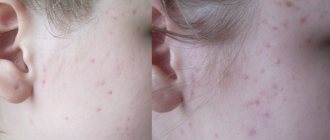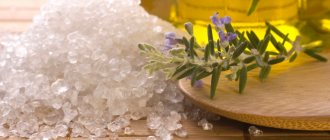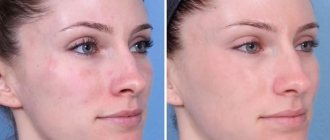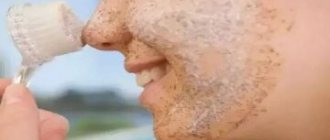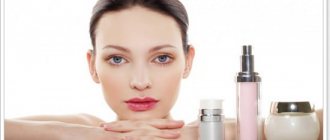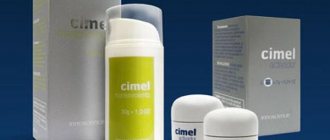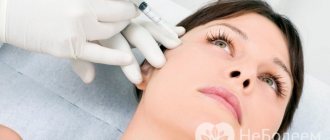REASONS FOR THE APPEARANCE OF STREAMS
The appearance of stretch marks (striae) is provoked by microtraumas of the skin and subcutaneous tissue (including cellulite). They appear when there is a hormonal imbalance and a lack of the hormone cortisol, which leads to protein deficiency and fragility of collagen fibers. As a result, when the skin is overstretched, tears form.
Stretch marks can appear in any person, regardless of gender and age, and there is often a genetic predisposition to this. At risk are:
| CATEGORIES OF PEOPLE | PROBLEM AREAS |
| Pregnant | Belly, chest |
| Adults and children suffering from sudden changes in weight | Waist, buttocks |
| Teenagers | Back and other rapidly growing parts of the body |
| Athletes gaining muscle mass | Shoulder girdle, hips |
Prevention
Since the appearance of stretch marks has underlying causes, their prevention should be based on an integrated approach:
- Balanced nutrition - it is necessary to introduce into the diet foods that increase the elasticity and regenerative abilities of cells: with vitamins C, B, E, A, P, phosphorus, magnesium, fatty acids (fish, nuts, citrus fruits);
- Massages stimulate blood circulation in the vessels and restore nutrition to the epidermis. Typically, massage with patchouli, wheat or sea buckthorn oils containing vitamins A, E and C, or hydromassage is used.
- Cosmetics - stretch marks are less likely to form on well-moisturized skin, so it is recommended to regularly rub in creams and oils containing vitamins A, E and fruit acids. Also, masks, wraps and injections in the area of stretch marks are recommended to moisturize and increase elasticity;
- Peels (exfoliation) of various types not only restore the nutrition of the epidermis and cell elasticity, but also help remove skin damage.
Horsetail for stretch marks.
Stretch marks (especially fresh ones) are perfectly smoothed out after using horsetail tincture for a month, thanks to the high silicon content. And silicon, in turn, promotes skin regeneration. You need to prepare a special lotion from horsetail. 50 grams of dry horsetail, juice squeezed from 1 lemon, pour 0.5 liters. vodka. Leave for 1 month. After a month, you need to add 0.5 liters to the resulting mixture. boiled water. This composition should be used to wipe stretch marks on the skin 2 times a day - morning and evening for a month. Stretch marks will become paler, many of them will disappear almost completely.
TYPES OF PEELING FOR STRETCH MARKS
Modern cosmetology offers many types of exfoliation, differing in components and methods of action. However, they all pursue one goal: to remove the stratum corneum of the epidermis and, as a result, to remove traces of stretch marks or at least make them less noticeable. Types of procedures are distinguished by the depth of impact (superficial, medium, deep) and method (mechanical, chemical and laser peels).
We recommend: What types of PROFESSIONAL FACIAL PEELINGS are there: from diamond chips to vulcanite
Mechanical
The essence of mechanical peeling is to remove the top layer of skin using solid particles contained in scrubs or abrasive compounds.
The most popular mechanical peelings are:
- Scrubs, brushing - affect the granular and horny layers of the epidermis. They are usually used to remove young and micro-striae, or to prevent stretch marks.
- Microdermabrasion (diamond exfoliation, coral exfoliation) - applies to the papillary layer of the skin. Used for relatively young, medium-sized stretch marks.
- Dermabrasion - affects the reticular layer of the epidermis. The most traumatic of all. Dermabrasion is used in the most severe, advanced cases and only as prescribed by a doctor.
Mechanical peeling also functions as a massage, and you can prepare an exfoliating composition yourself.
Chemical
Another popular type of exfoliation is chemical peeling for stretch marks. In this case, getting rid of stretch marks occurs with the help of acids, which, unlike mechanical peeling, do not erase, but dissolve dead cells.
Chemical exfoliation also includes superficial, medium and deep action. The depth of exposure is regulated by the type of acid and its concentration in the peeling composition.
Chemical exfoliation is also good because acids not only remove excess layers of skin, but also provoke the remaining cells to increase the production of collagen and elastin, which becomes a preventive measure against future stretch marks.
Compositions based on the following acids are usually used against stretch marks:
- Amber;
- Retinoic;
- Glycolic;
- Phenolic;
- AHA acids.
Acids are often mixed to achieve a better effect (for example, as in the Jessner peeling from MedicControlPeel, which combines several types of acids that simultaneously affect relief, pigmentation and the production of collagen and elastin).
Hardware
This exfoliation is controlled either by the liquid gas or by the size and temperature of the laser beam. Laser peeling is usually used for deeper interventions.
The following types of laser peeling are used today:
- Fractional thermolysis;
- Laser resurfacing;
- Laser nanoperforation.
After the procedure, the skin is burned and may take several weeks to several months to fully recover. However, the result is worth it.
Peeling on the stomach
Various types of peelings (exfoliation) are the most effective methods of combating stretch marks, which are widely used in both professional salons and at home.
Stretch mark peeling is a cosmetic procedure to restore the beautiful appearance of the skin by removing dead particles of the epidermis. Based on the depth of impact, there are superficial and intermediate procedures carried out at home, as well as deep peeling, which requires extensive experience and dexterity of a professional cosmetologist. The most effective types of peeling in the fight against stretch marks are:
- Chemical (including acid);
- Ultrasonic;
- Laser;
- Diamond;
- Coral peeling;
- Mechanical;
- Or use stretch mark creams.
Most popular: Eight effective treatments for hand skin rejuvenation
Procedures such as laser resurfacing, nanoperforation and diamond dermabrasion are also used to combat stretch marks.
PROS AND CONS OF THE PROCEDURE
The advantages of exfoliation are determined by the complexity of its action:
- Scars disappear or become less noticeable;
- Access to the papillary and reticular layers of the epidermis is opened, which stimulates restoration processes;
- The massage effect of mechanical peelings has a positive effect on blood circulation.
However, like any cosmetic procedure, peelings for stretch marks have their disadvantages:
- Swelling in the affected areas;
- Redness;
- Peeling;
- Bruising;
- Long recovery period when using any deep peels, as well as laser and chemical peels of medium impact.
We recommend: 5 recipes for PUMPKIN PEELING
Separately, it should be said about contraindications. Peeling is not recommended in the following cases:
- Diseases of the skin and blood vessels;
- Open wounds;
- Allergic reactions to the components of the exfoliating composition;
- Papillomas and suspicious moles;
- The use of certain hormones and medications that reduce blood viscosity;
- Keloids;
- Pregnancy (in consultation with your doctor).
Laser peeling
A radical method of combating this problem by increasing collagen production includes laser peeling. A positive result is achieved by using laser waves of different temperatures and sizes. During the procedure, the laser completely destroys fresh stretch marks and makes old and deep scars less noticeable.
Modern methods of laser treatment include:
- Grinding with a “cold” laser beam;
- Fractional thermolysis;
- Laser perforation.
After the procedure, the skin needs several months to recover. At this time, it is necessary to treat the affected areas with a special ointment and avoid exposure to the sun, so the procedure is carried out mainly in cold periods of the year.
HOW OFTEN TO DO
Using the procedure too often will cause new micro-tears in the skin, which will only worsen the problem of stretch marks. Therefore, for the procedure to bring a positive effect, it is advisable to adhere to the following schedule:
| Type of exfoliation | Treatment frequency |
| Surface | No more than 1-2 times a week as needed; |
| Median | From 3 to 10 sessions every 1-6 weeks, courses are repeated after 2-4 months; |
| Deep | It depends on the depth of atrophic changes and is prescribed by a doctor; most often it is a one-time procedure. |
The frequency of sessions and courses depends on the size and age of stretch marks, the types of peeling used and is determined by a specialist.
Fighting stretch marks at home
It makes no sense to say that stretch marks become a problem for every second woman - dealing with such complaints is very common among cosmetologists. However, not everyone can afford expensive procedures, peelings and operations, so you need to get out of the situation using mixtures at home.
Badyaga
Badyaga as a remedy has been known to everyone since childhood, and few people realized that it could be used as a way to get rid of stretch marks. Due to the silicon oxide content, badyaga forms microtraumas on the skin and this improves blood supply to the skin. Resorption of scars, scars and healing of damaged tissues are among the many results that the use of this product brings.
It is very important to choose a recipe for preparing a cream with badyagi that is suitable for a person’s skin type, otherwise there is a high probability of getting a burn or very unpleasant swelling.
In fact, badyaga is a life-saving thing for those with stretch marks. By irritating the skin, it causes cells to regenerate and repair, which helps eliminate stretch marks.
Coffee peeling
Coffee peeling
Caffeine beans, due to the content of useful minerals, cause accelerated metabolism and regeneration in cells. A scrub with a wrap can help not only make stretch marks less noticeable, but also get rid of them altogether if you take care of it in time. The normal frequency of using this method is once every 4-5 days. For those with delicate or dry skin – 7-8. It is necessary for each person to monitor changes in their body, as there is a possibility of developing an allergic reaction or any other intolerance to this method.
Lemon peeling
Lemon peeling can be an equally good way to prevent or get rid of stretch marks. To do this, mix finely grated lemon zest with low-fat yogurt or sour cream. Wrap the mixture around problem areas and after fifteen minutes, rinse with warm water.
Almond peeling
One of the most effective means of getting rid of stretch marks is almond peeling due to the high content of vitamin E. The composition includes mandelic acid, which penetrates deep enough to cleanse and force cells to regenerate, but at the same time does not harm health. Cosmetologists consider this method very good for getting rid of stretch marks.
Another advantage of this product is the ability to easily prepare the mixture at home without much effort. To do this you need almonds, almond oil, aloe juice. Everything is mixed and ground into powder. Peeling must be applied every 5-6 days.
Soda peeling
Baking Soda Peeling
Baking soda helps remove excess skin cells and creates small micro-traumas, which causes the skin to regenerate. You need to mix one teaspoon and a glass of water. Wipe the problem area in a circular motion, and rinse it off with warm water. It is recommended to do this procedure once a week to avoid redness, burns or an allergic reaction. A noticeable result will be visible in a few days, as the stretch marks will decrease and will not be as expressive.
TOP 8 HOME RECIPES
To prevent and remove small young stretch marks, you can peel stretch marks at home using available ingredients.
Coffee
Coffee is a product with vitamin PP, magnesium and phosphorus, which are responsible for cell regeneration. A safe scrub is recommended even in the most delicate situations, for example, after childbirth, and its frequent use is allowed.
The low-fat cream is combined with finely ground coffee (2 tsp) and mumiyo (4 g). Next, this mixture is applied to steamed skin and rubbed with a peeling washcloth in a circular motion into the problem area.
Citric
Lemon contains useful acids, vitamins A, C and B9, which are involved in the development and restoration of tissues, stimulating the production of elastin and collagen. Peeling is suitable for normal and oily skin and is often used to prevent and remove stretch marks on the abdomen. (Dry and sensitive people may react with irritation.)
There are several recipes for lemon peeling:
- Mix the grated zest of one lemon and 100 g of sour cream, add 2 drops of rosemary essential oil. Rub the mixture into the desired area of skin, leave for 20 minutes, and rinse.
- Combine equal parts lemon juice and water, apply to skin and rinse after 15 minutes.
After the procedure, it is important to use a moisturizer: lemon juice can dry out the skin. Use no more than once every 1-2 weeks.
With badyaga
Badyagi contains silicon, which, when it gets on the skin, stimulates blood flow and elastin production.
We recommend: PEELING AFTER BIOREVITALIZATION or AT THE SAME TIME? | The limits of reason
Bodyaga “works” in tandem with 3% hydrogen peroxide in a 1:1 ratio. Problem areas of the skin are wiped with the mixture and left to act for 15 minutes. Usually 10 sessions are enough for daily use.
Before using this peel, it is advisable to conduct an allergy test. In addition, badyaga is contraindicated during lactation and pregnancy.
Almond
Gentle almond peeling for stretch marks is suitable even for very sensitive and thin skin and is approved for frequent use. Mandelic acid gently exfoliates, has a lifting effect and does not dry out the skin.
Almond kernels and oatmeal are ground to a powder and mixed. This mixture is then combined with mandelic acid and aloe juice. The scrub is rubbed into the skin for several minutes and washed off.
BIO OIL, 23€ MAMA MIO, 52€ PALMERS, 5€
With iodine
Iodine peeling for stretch marks must be used with caution, since iodine can cause severe burns. The method is also contraindicated for sensitive skin and during pregnancy and lactation.
For stretch marks on the skin, a 5% iodine solution is used, which is applied to problem areas 4 times a day for 3 days. As a result, the roughened, burned tissue begins to peel off and is replaced by new, scar-free tissue. However, it is highly undesirable to use iodine peeling more than once every 2 months.
Soda
Baking soda cleanses well, brightens and gently exfoliates. To prepare a soda scrub, mix baking soda and finely ground salt in 1:1 proportions. Next, the mixture is rubbed into the skin with gentle movements for 1-12 minutes, after which it is washed off. After peeling, you need to apply a moisturizer. Use no more than once a week.
Phytopilling
Phytopilling uses only plant components, and its ingredients can be combined at will. Any ingredients can be added to the mixture: sea salt, lemon juice, badyaga, extracts of flax seeds and eleutherococcus, etc.
The resulting composition is applied to the skin for 15-20 minutes, or rubbed in for 1-2 minutes if solid particles are present.
Superficial peeling
Superficial peeling affects only the top layer of skin, and therefore is the most gentle and harmless cleaning method compared to other types of peeling. The penetration depth of the acid is minimal and does not cause irritation or redness.
Superficial peeling does not last long - from 10 to 20 minutes, so it is a very popular method of improving the skin. However, the result is not very noticeable - still, superficial peeling is more suitable for those with acne, rashes or uneven skin texture. Doctors recommend using top layer cleansing only for small and barely noticeable stretch marks.
Mechanical superficial peeling
The inexpensive and safe procedure captivates its consumers not only with its availability, but also with the use of natural resources (fruit seeds, cereals, etc.). Another advantage is the ability to carry out mechanical superficial peeling at home, buying special mixtures in pharmacies, cosmetic stores or cosmetologists, or doing them yourself. We cannot talk about any drastic changes during mechanical superficial peeling. Those who regularly use this procedure claim that the texture and color of the skin noticeably improves. Typically, superficial peeling is done before other procedures.
Chemical superficial peeling
A chemical superficial peel can be used as a stand-alone treatment to improve skin tone or as a preparation before other treatments, such as a mid- or deep clean. It is worth knowing that chemical peeling is sometimes performed under anesthesia, as it is done with acids and enzymes. The procedure may take about 30 minutes.
After chemical peeling, slight redness is noticed, which goes away after a few hours. Regardless of which acid is used for peeling, a similar algorithm of actions must be followed:
- skin cleansing;
- applying the solution;
- After a few minutes, the solution is removed.
It is very important to neutralize the acid solution in time when applied to skin with stretch marks in order to control the depth of penetration of the acid and also to avoid getting burned. This method is rarely used now because toxic solutions can leave small scars on the skin.
Hardware superficial peeling
The name speaks for itself - various equipment is used for peeling. And one of the most popular hardware cleaning methods is laser peeling. Stretch marks on the skin are polished with a laser beam, and most often the stretch marks completely disappear. However, this procedure cannot be carried out without careful preparation - you need to rub in creams with a sufficient amount of vitamin C for several weeks.
Laser peeling
Laser peeling is considered the highest quality method of skin cleansing, despite the fact that the skin does not look beautiful the first time after the procedure. Swelling, slight redness, and a burning sensation may be accompanied by several days or weeks, so it is very important to consult a cosmetologist who will prescribe a special ointment to alleviate the condition. This peeling is a full-fledged medical operation, so it is advisable to carry it out under the supervision of doctors.
How to get rid of stretch marks using hardware technology?
Correction using laser equipment is used as a radical method of therapy. The method is based on the ability of the skin under the influence of a laser to enhance the production of collagen and elastin fibers.
Today cosmetologists use:
- Laser resurfacing - a laser beam evaporates the surface layer of skin. Removal of shallow stretch marks is carried out with an erbium (“cold”) laser. A variation of this type of treatment is the Fraxel laser. For deep scars, a CO2 laser will be effective.
- Fractional thermolysis – in which fragmentary removal of skin cells is carried out using heat. To ensure minimal damage, the laser beam is split into microbeams that make up a grating, and the size of the point action does not exceed 0.1 mm. Fractional thermolysis technology allows you to remove scars of varying depths and ages.
- Laser nanoperforation - the device uses a special attachment that divides the beam not into “micro” but into “nano” rays, which allows the procedure to be carried out with the least invasiveness and achieve almost complete renewal of the skin in the treatment area.
Read more about laser treatment for stretch marks by following the link.
Non-injection mesotherapy . The introduction of therapeutic drugs is carried out using hardware techniques: ultrasound, electric current, oxygen supplied under pressure, etc. Medicines used include hyaluronic acid, enzymes that destroy scar tissue, antioxidants, and silicon-based preparations. To improve cell permeability, physiotherapeutic methods such as iontophoresis and ultrasonic phonophoresis are used.
Removing stretch marks on the body with peelings
To correct stretch marks, both chemical peelings and mechanical grinding are used.
- Chemical peeling is selected depending on the depth and number of stretch marks. Before the procedure, consult a cosmetologist, as each type of chemical peeling has its own indications and contraindications. The most commonly used are medium and deep peelings using acids (alpha-hydroxy acids, beta-hydroxy acids, salicylic, lactic, phenolic, trichloroacetic acids and others).
- Diamond microdermabrasion , which is also called mechanical resurfacing and is carried out in cases where it is necessary to remove the stratum corneum of the epidermis, while leveling the relief of scar formations. A distinctive feature of the procedure is the combination of massage and grinding process, which is achieved using mechanical micropulsation.
What types of peelings are there?
Peels are divided into superficial, medium and deep, as well as mechanical, chemical and hardware. They can also be grouped by the active substance used in the procedure.
Let's take a quick look at some of them.
Mechanical peeling
Mechanical peeling is the smoothing of the skin using aluminum oxide powder or other substances. A specialized apparatus sprays powder under pressure, the particles of which remove the dead layer of the epidermis and cleanse the pores.
Mechanical peeling for stretch marks is a painless procedure. It does not cause damage to the deep layers of the skin, which means it eliminates infection.
Chemical peeling
Chemical peeling is carried out using special compounds that cause a controlled burn of the upper layer of the epidermis, followed by exfoliation of dead cells.
This procedure cleanses the skin and causes the accelerated appearance of new collagen, which leads to improved elasticity and improved skin tone.
Acids for chemical peeling
There are 3 types of chemical peeling – superficial, medium and deep. Each of these procedures is carried out using a special composition:
- Superficial peeling is carried out using fruit acids. These substances are hidden under the acronym AHA. They are able to penetrate the upper layer of the epidermis and exfoliate the keratinized layers.
- Medium peeling is performed using an acid with a greater degree of penetration - trichloroacetic or salicylic. These types of acids help fight deep wrinkles, scars and stretch marks.
- Deep peeling is carried out using phenol. It penetrates into the deepest layers of the epidermis and affects all components of the skin.
Let's take a closer look at what acids are used in peelings for stretch marks.
succinic acid
Succinic acid is a unique substance that improves cell functioning, restores and rejuvenates, smoothes and cleanses the skin.
Succinic acid is used to remove stretch marks, and it can also create uniform skin pigmentation.
Fruit acids
